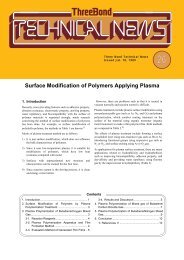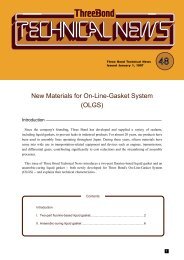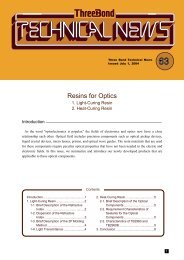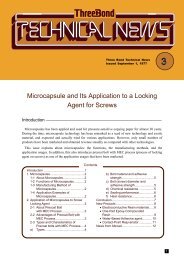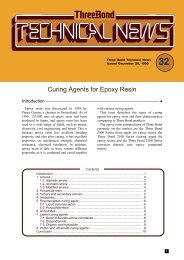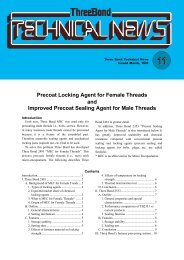Pressure resistance mechanism of reaction-type liquid gaskets (Part 2)
Pressure resistance mechanism of reaction-type liquid gaskets (Part 2)
Pressure resistance mechanism of reaction-type liquid gaskets (Part 2)
Create successful ePaper yourself
Turn your PDF publications into a flip-book with our unique Google optimized e-Paper software.
The material failure equation represents the<br />
relationship between the physical destructive force<br />
due to fluid pressure in use and the properties <strong>of</strong><br />
<strong>liquid</strong> <strong>gaskets</strong>. Therefore, the effects <strong>of</strong> heat and the<br />
chemical properties <strong>of</strong> the fluid must be considered<br />
as variables that affect adhesive force and cohesive<br />
force (including elastic modulus and tensile<br />
strength).<br />
state (a) is quickly reached, force Psinθ (which<br />
remains below destructive levels) given by the<br />
material failure equation is generated. As pressure<br />
increases, destruction states (b) and (c) are initiated,<br />
followed by state (d), initiating self-sealing.<br />
6-2. Self-sealing action and extrusion effect<br />
Solid <strong>gaskets</strong> require large contact surface<br />
pressure due to their pressure <strong>resistance</strong> <strong>mechanism</strong>,<br />
and leakage will occur if fluid pressure exceeds<br />
contact surface pressure. In the case <strong>of</strong> O-rings, the<br />
contact surface pressure deriving from assembly is<br />
not so large and the pressure is maximum at the<br />
center as shown in Figure 32-a. However, when<br />
fluid pressure is applied, the pressure is added to the<br />
original contact surface pressure, as shown in<br />
Figure 32-b, resulting in larger contact surface<br />
pressure because the O-ring is confined in the<br />
groove. This means that the maximum value <strong>of</strong><br />
contact surface pressure is Pm, which is larger than<br />
the value <strong>of</strong> fluid pressure P1, and no leakage<br />
occurs. The remarkably useful sealing action, in<br />
which fluid pressure is added to the contact surface<br />
pressure, is called self-sealing action.<br />
Figure 33. Self-sealing action <strong>of</strong> high modulus<br />
<strong>liquid</strong> <strong>gaskets</strong><br />
Assembly force kg<br />
Gap<br />
Immediately after coating P=0<br />
Compressed area<br />
Outside<br />
Liquid<br />
pressure P 1<br />
(a) O-ring (No fluid pressure is applied.)<br />
(b) Condition that prevents leakage from O-ring<br />
Figure 32. Distribution <strong>of</strong> contact surface<br />
pressure for O-ring<br />
In cases in which <strong>reaction</strong>-<strong>type</strong> <strong>liquid</strong> <strong>gaskets</strong><br />
may be destroyed, such a self-sealing <strong>mechanism</strong> is<br />
expected to function in the case <strong>of</strong> elastic materials.<br />
In Figure 33, when fluid pressure is applied and<br />
Figure 34. Extrusion effect <strong>of</strong> <strong>liquid</strong> <strong>gaskets</strong><br />
Although most <strong>liquid</strong> <strong>gaskets</strong> will exhibit<br />
extrusion in general use, the extrusion generated by<br />
high modulus <strong>liquid</strong> <strong>gaskets</strong> results in self-sealing<br />
action, as shown in Figure 34. Table 6 shows the<br />
results <strong>of</strong> tests on Three Bond 1215.<br />
Table 6. Extrusion effects associated with TB<br />
1215<br />
Testing condition Leakage pressure (kg/cm 2 )<br />
Average surface<br />
pressure kg/cm 2<br />
When pressure is<br />
applied.<br />
Pl value<br />
kg/cm 2<br />
With<br />
extrusion<br />
Extrusion is<br />
removed.<br />
50 22.5 68 53<br />
20 7.5 55 33<br />
* The test flange shown in Figure 6 was used.<br />
2




